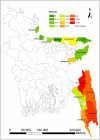The role of climate variability in the spread of malaria in Bangladeshi highlands
- PMID: 21179555
- PMCID: PMC3002939
- DOI: 10.1371/journal.pone.0014341
The role of climate variability in the spread of malaria in Bangladeshi highlands
Abstract
Background: Malaria is a major public health problem in Bangladesh, frequently occurring as epidemics since the 1990s. Many factors affect increases in malaria cases, including changes in land use, drug resistance, malaria control programs, socioeconomic issues, and climatic factors. No study has examined the relationship between malaria epidemics and climatic factors in Bangladesh. Here, we investigate the relationship between climatic parameters [rainfall, temperature, humidity, sea surface temperature (SST), El Niño-Southern Oscillation (ENSO), the normalized difference vegetation index (NDVI)], and malaria cases over the last 20 years in the malaria endemic district of Chittagong Hill Tracts (CHT).
Methods and principal findings: Monthly malaria case data from January 1989 to December 2008, monthly rainfall, temperature, humidity sea surface temperature in the Bay of Bengal and ENSO index at the Niño Region 3 (NIÑO3) were used. A generalized linear negative binomial regression model was developed using the number of monthly malaria cases and each of the climatic parameters. After adjusting for potential mutual confounding between climatic factors there was no evidence for any association between the number of malaria cases and temperature, rainfall and humidity. Only a low NDVI was associated with an increase in the number of malaria cases. There was no evidence of an association between malaria cases and SST in the Bay of Bengal and NIÑO3.
Conclusion and significance: It seems counterintuitive that a low NDVI, an indicator of low vegetation greenness, is associated with increases in malaria cases, since the primary vectors in Bangladesh, such as An. dirus, are associated with forests. This relationship can be explained by the drying up of rivers and streams creating suitable breeding sites for the vector fauna. Bangladesh has very high vector species diversity and vectors suited to these habitats may be responsible for the observed results.
Conflict of interest statement
Figures





Similar articles
-
Climatic fluctuations and malaria transmission dynamics, prior to elimination, in Guna Yala, República de Panamá.Malar J. 2018 Feb 20;17(1):85. doi: 10.1186/s12936-018-2235-3. Malar J. 2018. PMID: 29463259 Free PMC article.
-
El Niño and other climatic drivers of epidemic malaria in Ethiopia: new tools for national health adaptation plans.Malar J. 2023 Jun 24;22(1):195. doi: 10.1186/s12936-023-04621-3. Malar J. 2023. PMID: 37355627 Free PMC article.
-
Impact of climate change on vector-borne diseases: Exploring hotspots, recent trends and future outlooks in Bangladesh.Acta Trop. 2024 Nov;259:107373. doi: 10.1016/j.actatropica.2024.107373. Epub 2024 Aug 28. Acta Trop. 2024. PMID: 39214233 Review.
-
The role of ENSO in understanding changes in Colombia's annual malaria burden by region, 1960-2006.Malar J. 2009 Jan 8;8:6. doi: 10.1186/1475-2875-8-6. Malar J. 2009. PMID: 19133152 Free PMC article.
-
El Niño and associated outbreaks of severe malaria in highland populations in Irian Jaya, Indonesia: a review and epidemiological perspective.Southeast Asian J Trop Med Public Health. 1999 Dec;30(4):608-19. Southeast Asian J Trop Med Public Health. 1999. PMID: 10928348 Review.
Cited by
-
The role of age, ethnicity and environmental factors in modulating malaria risk in Rajasthali, Bangladesh.Malar J. 2011 Dec 15;10:367. doi: 10.1186/1475-2875-10-367. Malar J. 2011. PMID: 22171950 Free PMC article.
-
Malaria prevalence, risk factors and spatial distribution in a hilly forest area of Bangladesh.PLoS One. 2011 Apr 21;6(4):e18908. doi: 10.1371/journal.pone.0018908. PLoS One. 2011. PMID: 21533048 Free PMC article.
-
Seasonal abundance of Anopheles mosquitoes and their association with meteorological factors and malaria incidence in Bangladesh.Parasit Vectors. 2014 Sep 18;7:442. doi: 10.1186/1756-3305-7-442. Parasit Vectors. 2014. PMID: 25233890 Free PMC article.
-
Spatio-temporal distribution of malaria and its association with climatic factors and vector-control interventions in two high-risk districts of Nepal.Malar J. 2014 Nov 25;13:457. doi: 10.1186/1475-2875-13-457. Malar J. 2014. PMID: 25421720 Free PMC article.
-
Malaria incidence trends and their association with climatic variables in rural Gwanda, Zimbabwe, 2005-2015.Malar J. 2017 Sep 30;16(1):393. doi: 10.1186/s12936-017-2036-0. Malar J. 2017. PMID: 28964255 Free PMC article.
References
-
- WHO. 2009. World malaria report 2008.
-
- M&PDC. 2010. Malaria Country Report Bangladesh - 2009.
-
- Elias M, Dewan R, Ahmed R. Vectors of malaria in Bangladesh. J Prev Social Med. 1982;1:20–28.
Publication types
MeSH terms
LinkOut - more resources
Full Text Sources
Medical

